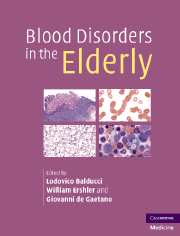Book contents
- Frontmatter
- Contents
- List of contributors
- Preface
- Part I Epidemiology
- Part II Hematopoiesis
- 5 Stem cell exhaustion and aging
- 6 Hematopoietic microenvironment and age
- 7 Replicative senescence, aging, and cancer
- 8 Qualitative changes of hematopoiesis
- 9 Aging and hematopoietic stress
- 10 Immunoglobulin response and aging
- 11 Biological and clinical significance of monoclonal gammopathy
- Part III Anemia of aging
- Part IV Hematologic malignancies and aging
- Part V Disorders of hemostasis in the elderly
- Index
10 - Immunoglobulin response and aging
from Part II - Hematopoiesis
Published online by Cambridge University Press: 21 October 2009
- Frontmatter
- Contents
- List of contributors
- Preface
- Part I Epidemiology
- Part II Hematopoiesis
- 5 Stem cell exhaustion and aging
- 6 Hematopoietic microenvironment and age
- 7 Replicative senescence, aging, and cancer
- 8 Qualitative changes of hematopoiesis
- 9 Aging and hematopoietic stress
- 10 Immunoglobulin response and aging
- 11 Biological and clinical significance of monoclonal gammopathy
- Part III Anemia of aging
- Part IV Hematologic malignancies and aging
- Part V Disorders of hemostasis in the elderly
- Index
Summary
Introduction
Structure, classes, and functions of immunoglobulins
Immunoglobulins (Igs) are a group of structurally similar proteins produced exclusively by plasma B cells in response to an immunogen — such as a vaccine — and which function as antibodies. Igs are a major serum component, comprising more than 20% of the total plasma proteins. The basic unit of Igs contains two heavy chains (molecular weight of 50–70 kD each) and two light chains (about 23 kD each), forming a “Y” shape, with the light chains attaching to both arms of the Y. The top areas of the arms, termed the variable region, are highly variable and contain the binding domain specific to an antigenic area (antigenic domain) on the immunogen. It is estimated that there are up to 1011 different Igs in the Ig repertoire. This Ig diversity is achieved mainly by gene rearrangement of Ig genes in B cells.
There are five different classes of Ig in human blood, corresponding to the five different classes of Ig heavy chains γ (IgG), α (IgA), μ (IgM), δ (IgD), and ε (IgE). Any one of these heavy chains can pair with two different light chains, κ and λ. Details of these Ig classes, together with their functions, can be found in Table 10.1.
Through direct binding to microbial particles, Igs can neutralize the microbial infectivity, protecting and helping the host to recover. In addition, the binding of Igs can also induce other immunological events, such as killing microbial or infected cells, via NK-cell activation or complement fixation pathways.
- Type
- Chapter
- Information
- Blood Disorders in the Elderly , pp. 129 - 137Publisher: Cambridge University PressPrint publication year: 2007



